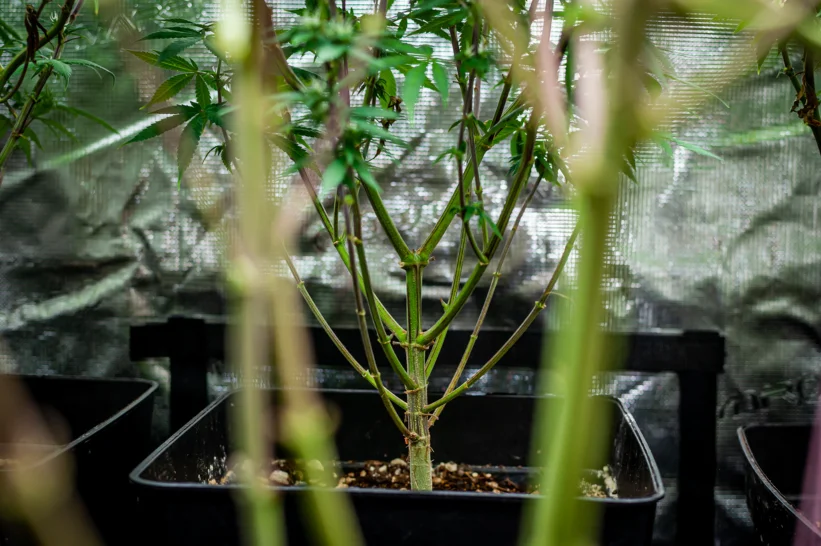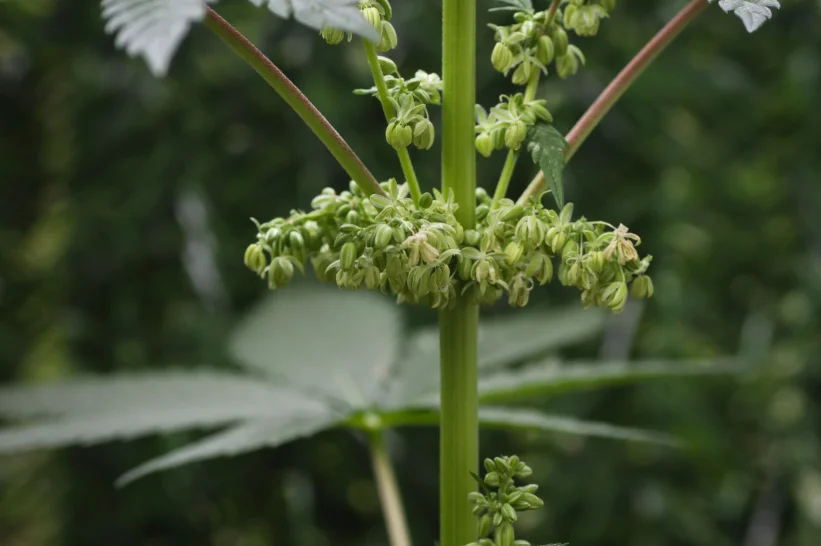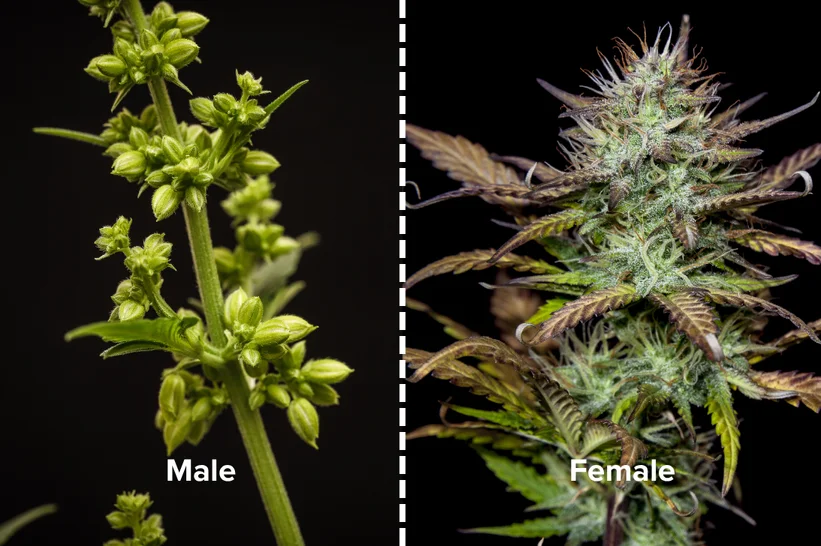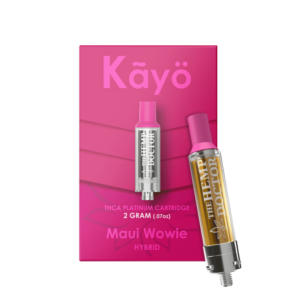Like most living creatures, cannabis plants have two genders: male and female. And if you’ve been around the magic herb long enough, you’ve likely consumed the latter since it is the more preferred variant of the two.
This isn’t to say that the male cannabis plant should be ignored, which is why this article aims to provide more information about it. We’ll get into more nitty-gritty details about its physical traits, how these plants are during their growth stage, and ways to distinguish them from female plants.
For all cannabis enthusiasts seeking to deepen their knowledge, be sure to read on until the end.
🔑 Key Traits of a Male Cannabis Plant
- The presence of pollen sacs, ball-shaped structures
- Less bushy and more upright
- Thicker stems with fewer leaves and buds
- Grows taller and faster compared to female plants
- Lack of pistils, the hairlike structures on the surface, commonly seen in female plants
- Flowering begins earlier, within three weeks after germination
Key Physical Traits of a Male Cannabis Plant
Male cannabis plants often get a bad rap because, for one, they don’t contain high concentrations of the precious cannabinoids that most users are after. And when they pollinate with females, they may also lessen the potency of the buds they end up procreating.
With this in mind, many beginner cultivators, in particular, have likely asked important questions like, “What does a male cannabis plant look like?” “What key features do I look out for?”
Here’s a quick answer: you won’t be able to differentiate male and female plants at first glance. That’s because the distinguishing factors won’t appear until the early seedling phase, which is within the two-to-three-week mark after germination.
However, deciphering genders may be challenging even then. You will need a magnifying glass and some experience to develop a good eye and make clear distinctions moving forward.
But as a starting point, here are some telltale signs you can look out for:
- The presence of pollen sacs, ball-shaped structures that eventually burst and release pollen
- They appear less bushy and more upright
- They have thicker stems with fewer leaves and buds
- They grow taller and faster compared to female plants
- Lack of pistils, the hairlike structures on the surface, which are commonly seen in female plants
- Flowering begins earlier, within three weeks after germination
What Does a Male Cannabis Plant Look Like in the Vegetative Stage?

The vegetative stage of the cannabis life cycle is a crucial one, to say the least. It’s during this phase that the plant begins to build a more formidable foundation as it grows.
It’s also during this phase that the plant begins to take shape. In the case of male cannabis variants, it is when they start to grow taller and tower over their female counterparts.
However, the plant’s gender isn’t distinguishable yet, as the pollen sacs have yet to appear. In this case, the height would be the clearest indicator of it being male.
What Does a Young Male Cannabis Plant Look Like?

Most of the telltale signs we mentioned above typically appear during the pre-flowering stage of the cannabis plant.
During the first four to six weeks after germination, the pollen sacs will begin to show and become the most distinctive feature. These sacs appear in clusters and resemble small bananas.
The male plant’s specific features will also begin to show, particularly the thicker, sturdier stalks with fewer leaves and buds. They can grow up to 20 inches in height, but sativa varieties tend to be generally taller.
What Does a Flowering Male Cannabis Plant Look Like?

You can compare the cannabis plant’s flowering stage to a person’s life after puberty. Growth begins to slow down as the body develops physical features that will define a person’s overall appearance upon entering adulthood.
So, what does a male cannabis plant look like during the flowering phase? It becomes more about resin production and developing buds. However, male variants don’t produce as many buds. Instead, their pollen sacs begin to stand out. These sacs will eventually open and release pollen to fertilize female plants.
These sacs would typically appear as small, round-shaped clusters that look like grapes when they’ve fully developed. And unlike females, the absence of pistils is also visibly noticeable.
If you intend to produce all-female crops, the flowering stage would be the best time to get rid of male plants, before they get into the process of fertilization.
Male Cannabis Plant vs. Female Cannabis Plant

In an earlier section, we discussed the main differences between a male and female cannabis plant. In a nutshell, the former does not produce buds and typically grows taller than the latter.
We also mentioned that the plant’s reproductive organs don’t appear until the later stages of its life cycle. If you’re a grower who uses this as a primary distinguishing parameter, this may be a challenge for you.
So, for this section, we’ll break down the differences between male and female plants. You will see each one listed on the table below, which should help you clearly distinguish between the two.
| Male Plants | Female Plants |
| Thicker, sturdier stalksFewer leaves and zero budsTaller in heightVisible appearance of pollen sacs | More slender stalksThicker leaves and buds that produce resinShorter but bushierThe presence of fine translucent hairs to facilitate fertilization and seed production |
Male Cannabis Plant vs. Hermaphrodite
Cannabis plants usually have only one set of reproductive organs. If you’re a grower, you would want to be able to identify them to achieve the type of crops you desire.
But sometimes, the plants you’re caring for end up developing both organs, making it quite a difficult situation for you. In this case, you’re likely dealing with a hermaphrodite plant.
Otherwise known as “hermies,” these plants are typically a byproduct of stress on the female variant. Some known stress factors include light leaks, as well as exposure to high temperatures and humidity that is significantly below optimal levels.
Seasoned growers know that both males and hermaphrodites are the undesirable elements in the grow room or garden. Not only do they produce flowerless, budless plants that likely have lower yields, but they can also pollinate with females to produce more undesirables.
Identifying a hermaphrodite plant can be challenging, especially since you will need to wait until the third week to spot the reproductive organs. However, the signs may show up early.
Hermies will have both organs. If you chance upon a thicker, bushier female plant with a pollen sac and pistil, you’re likely dealing with one.
Your best course of action from here would be to remove the undesirable plant to prevent further pollination. Also, don’t forget to inspect the rest of your crops to see if there are other visible signs of hermaphroditism.
Why Identifying Male Cannabis Plants Matters?
Especially if you’re in the retail or cultivation industry, knowing your plant’s gender is essential. This process is called gender screening, where you identify whether you have predominantly male or female crops.
Gender screening enables you to gauge your desired harvest accurately. It significantly affects the quality and yield of your final product. And as we’ve discussed in previous sections, if you’re after bigger yields and more buds, you would want more female plants.
If that is the case, identifying male plants greatly matters. Not only does it help prevent pollination and the development of male seeds, but it also ensures consistency in your final product.
Apart from looking for telltale signs of male cannabis development, you can also have your plants undergo DNA testing. Although it may be slightly more rigorous and expensive, it will provide more accurate results.
What To Do If You Find a Male Plant?
As we previously mentioned, male cannabis plants are generally considered “undesirables” in the grow room or garden. Therefore, taking immediate action is necessary if you spot signs of male plant growth.
The first thing you would want to do is to isolate them from the rest of your crops before discarding them. Doing this minimizes the risk of possible pollination with the females. However, if you are planning to use the male’s pollen for other purposes, simply isolate them in a separate space far away from your female crops.
Regular monitoring is also necessary as a means of quality control. But if there comes a point where you’re unsure about whether you’re dealing with a male plant or not, testing kits may come in handy. These kits can help determine gender even when the plants are still seedlings.
However, if you require further assistance, experienced growers can also offer valuable insights.
Can You Use Male Cannabis Plants for Anything?
Despite being labelled “undesirable,” male cannabis plants also have uses. If you happen to spot one, you may want to save some of them for specific purposes, which we will discuss in this section.
Advantageous DNA Traits
For one, the male DNA has its fair share of advantageous traits. Their growth rate is typically higher, along with their ability to resist mold development and ward off pests. Having these traits transferred to young crops may be advantageous for their development and growth.
Natural Pesticides
And given the male plant’s purported pest-resistant qualities, they may also serve as effective pesticides for other plants. Studies have shown that cannabis can ward off pests, which is why some cultivators have grown male species to repel cotton worms, cabbage caterpillars, and potato beetles.
Rare Male Cannabis Strain Can Contain High Levels of THC
In previous sections, we also mentioned that male plants typically lack the potency that females do. However, this isn’t always the case, especially in crops found in Middle Eastern regions, such as Lebanon, Turkey, and Morocco.
A 1971 study reported such findings, revealing that while the cannabinoid content in male plants was lower, variants like the Hizzine 3.9.1969 showed higher concentrations of THC. It only proves that the male species isn’t completely useless, as it is generally perceived.
How to Make a Male Cannabis Plant Female?
Cannabis plants, humans, and animals share a similar chromosome trait. Males have an XY chromosome configuration, and females have an XX chromosome configuration.
However, cannabis crops are more flexible in that growers can take specific measures to have them exhibit characteristics of the opposite gender. In this case, subjecting plants to stress conditions, such as irregular light cycles or inducing physical damage like topping or super cropping, can help induce male plants to produce female flowers.
This process is known as “herming,” where the plant essentially turns into a hermaphrodite. While it isn’t a complete conversion, cultivators can adjust their growing process in a way that highlights the female traits more prominently.
However, it is essential to keep in mind that hermaphrodite plants can self-pollinate. If you’re intent on growing a specific species, the growth of hermies is something to keep an eye out for.
Conclusion
Generally, male cannabis plants are not the preferred crop for most growers. They lack the desired qualities that most people are after, such as yield, bud and resin content, and potency.
However, male plants also have specific purposes that make them useful. They are excellent for breeding and can help ward off pests and molds when placed next to other types of plants.
Ultimately, it all comes down to purpose and preference. If you prefer growing female plants, you would want to isolate the males or even discard them altogether. But if you are after the benefits of having male crops, it would be beneficial to keep them around.
Speaking of flowers, you may want to check out The Hemp Doctor Wholesale’s THCA flowers. You can choose from different variants such as Martian Candy, Stardog Guava, and Gelato float, among many others. The great thing is you can buy them in bulk.
FAQs
Before we wrap up this article, we will answer some of the most frequently asked questions about male cannabis plants.







